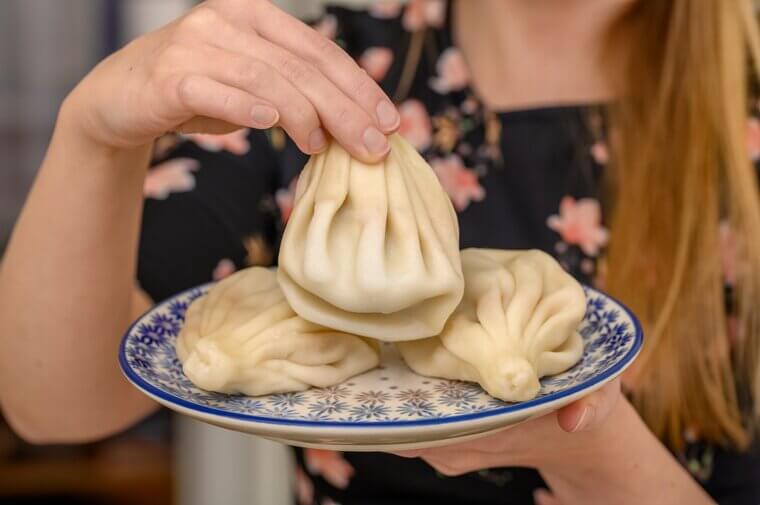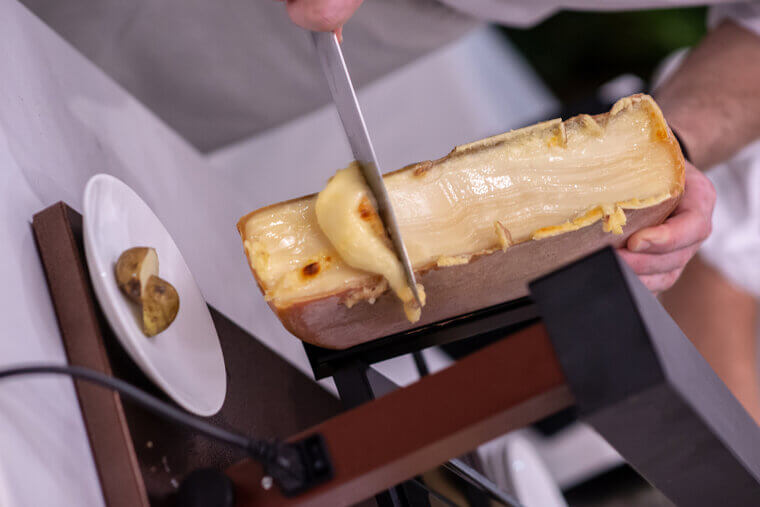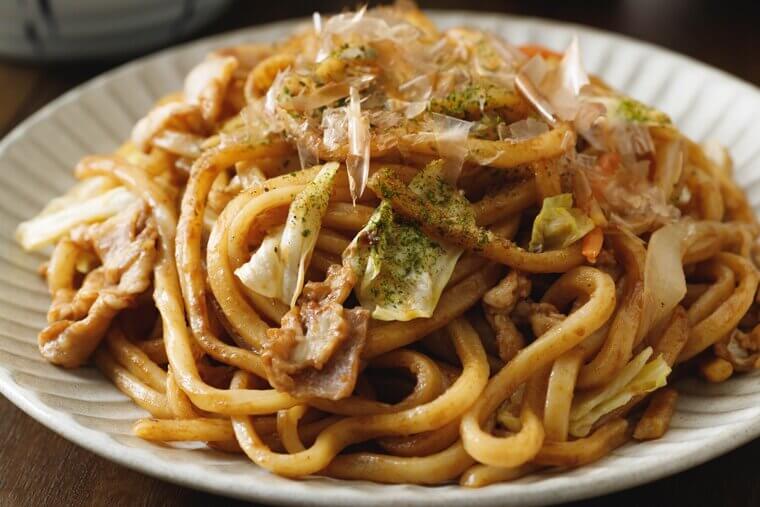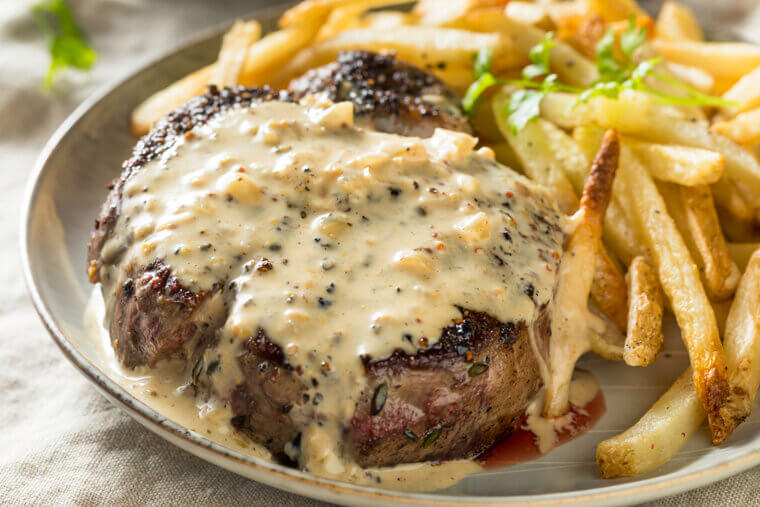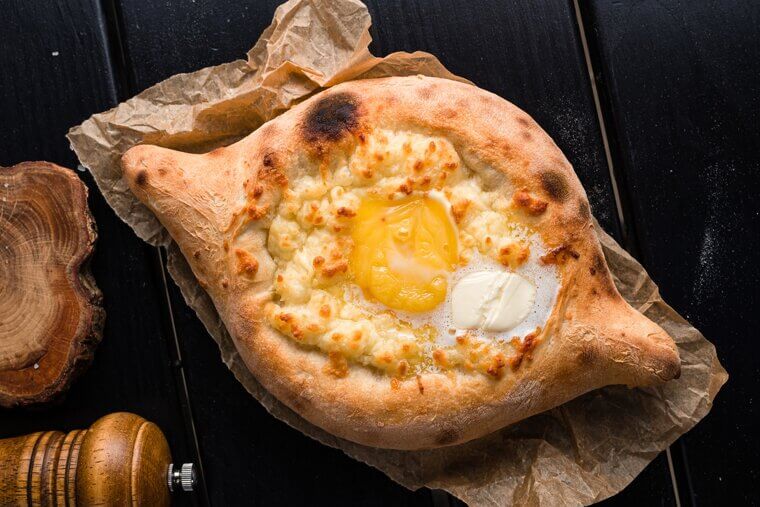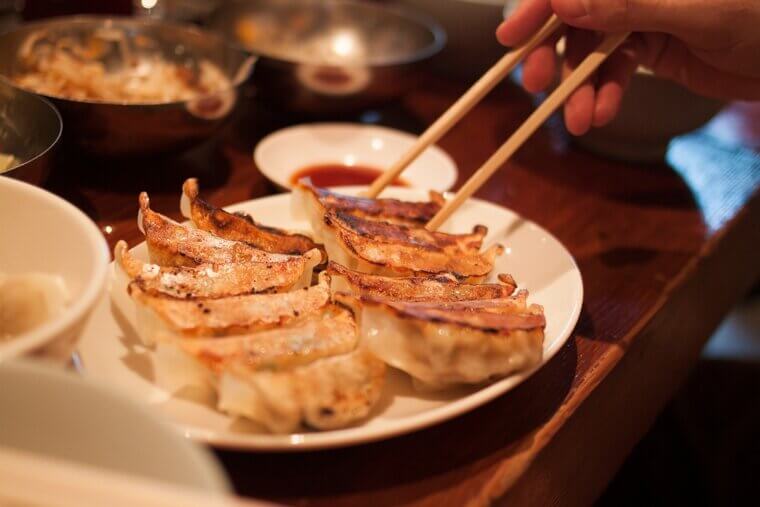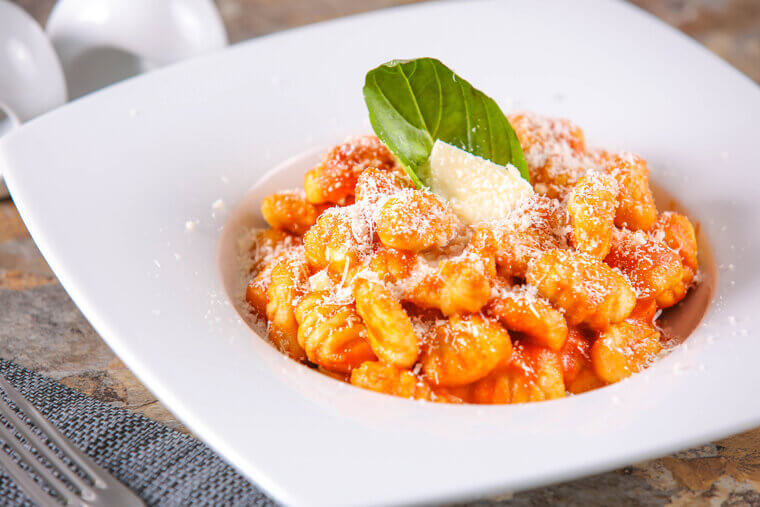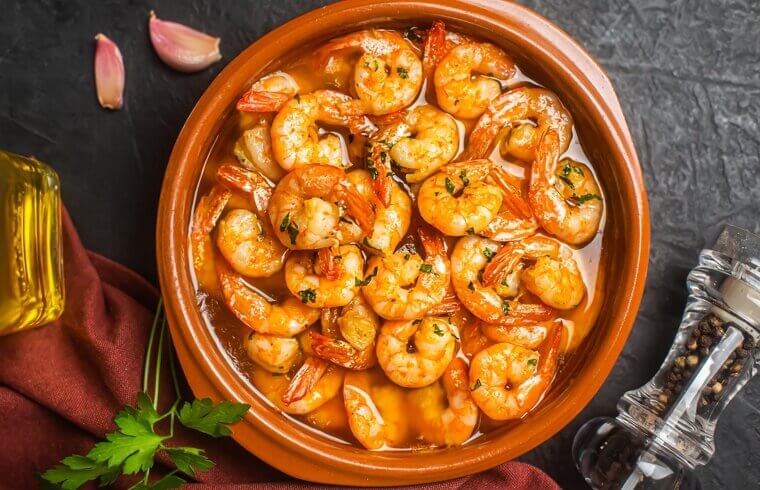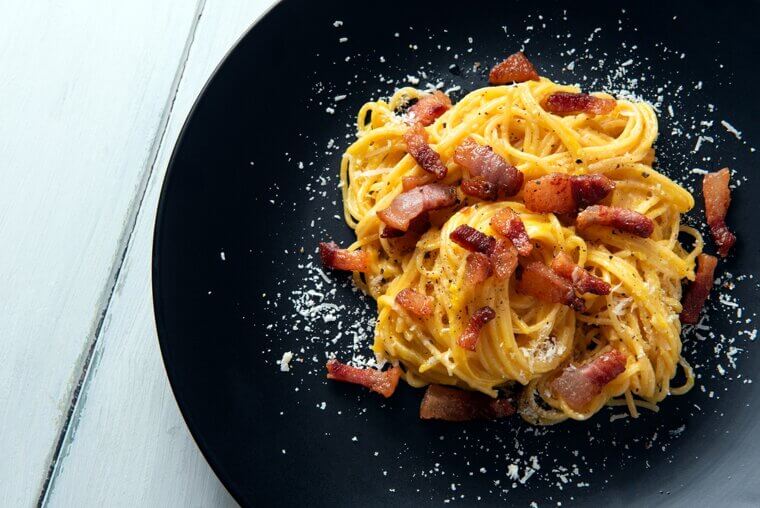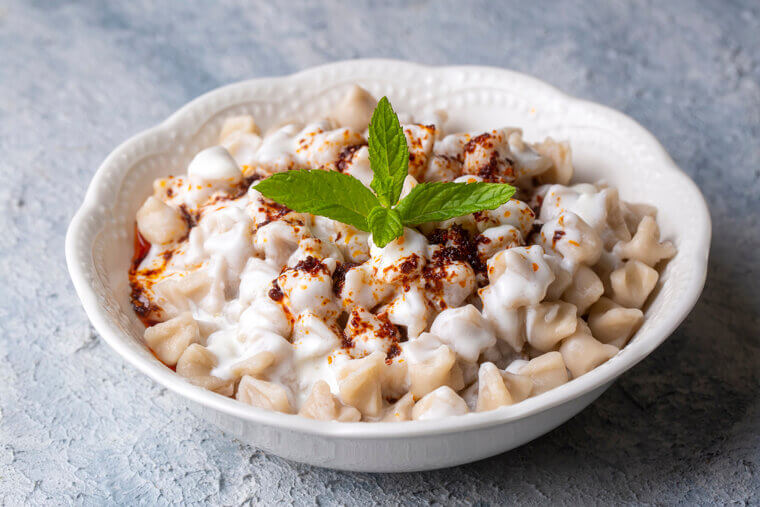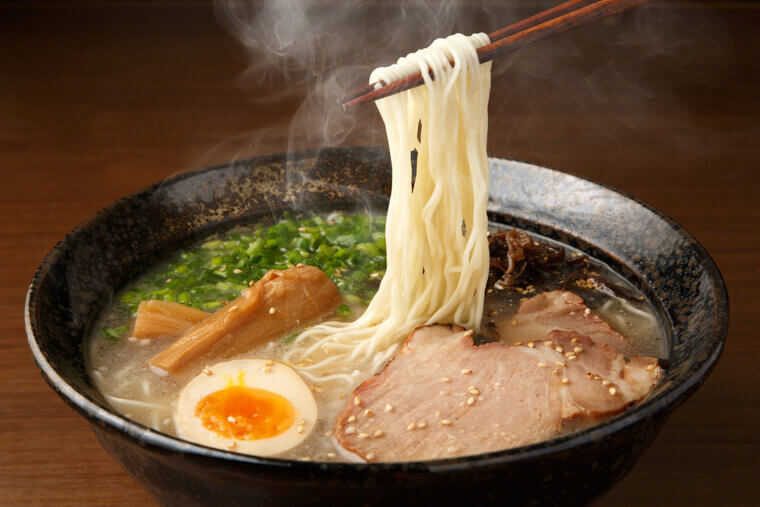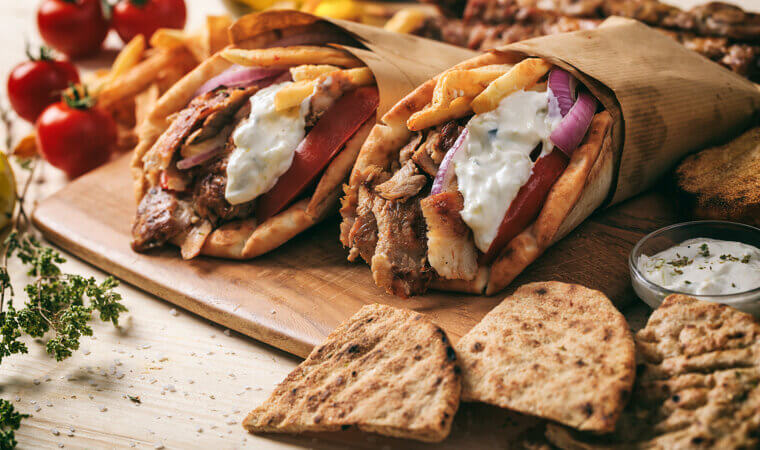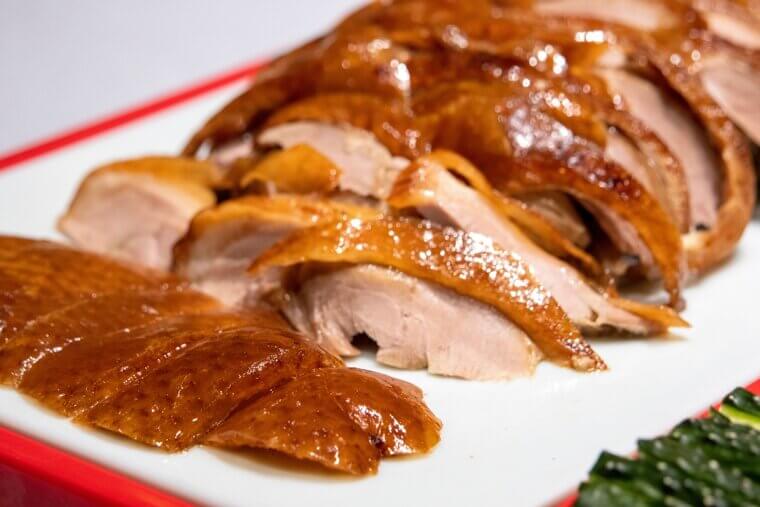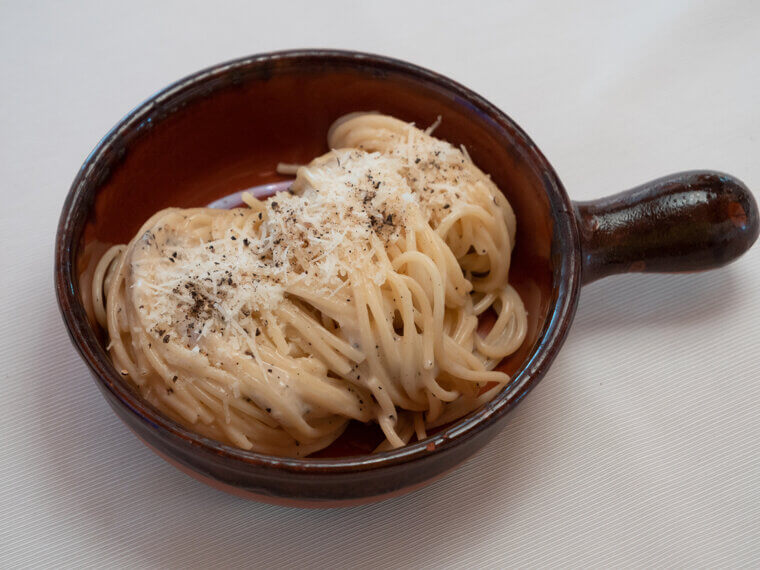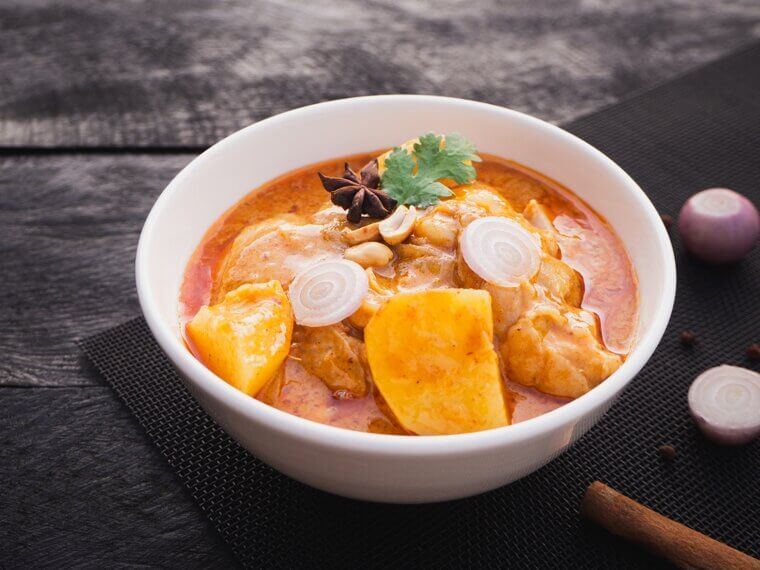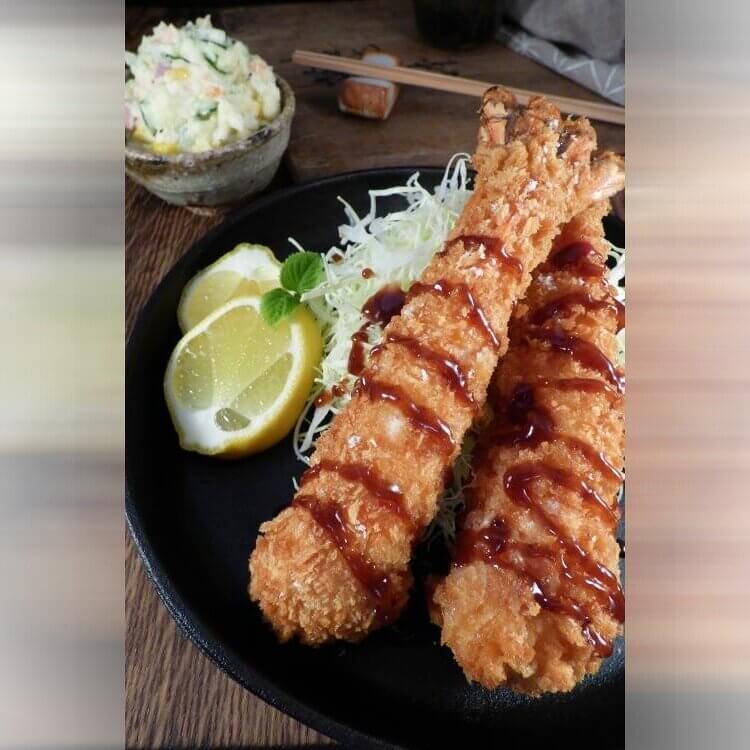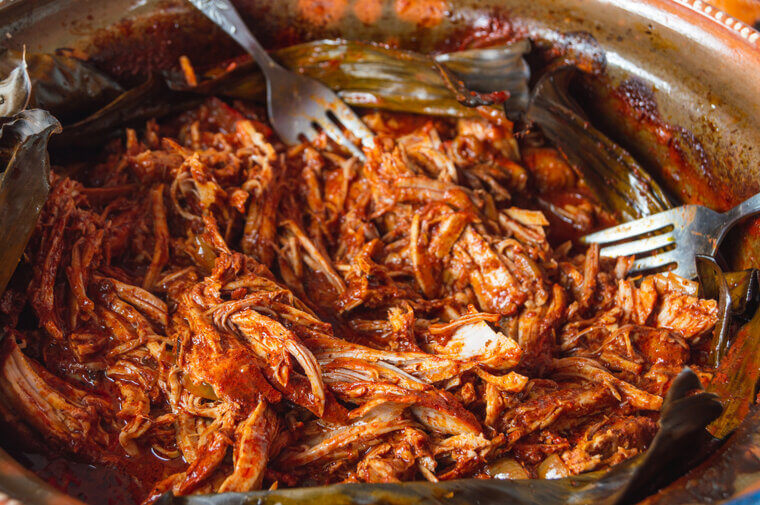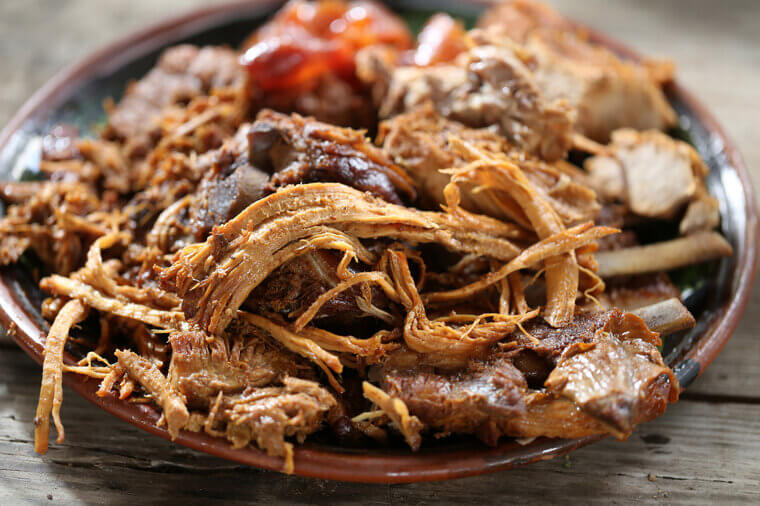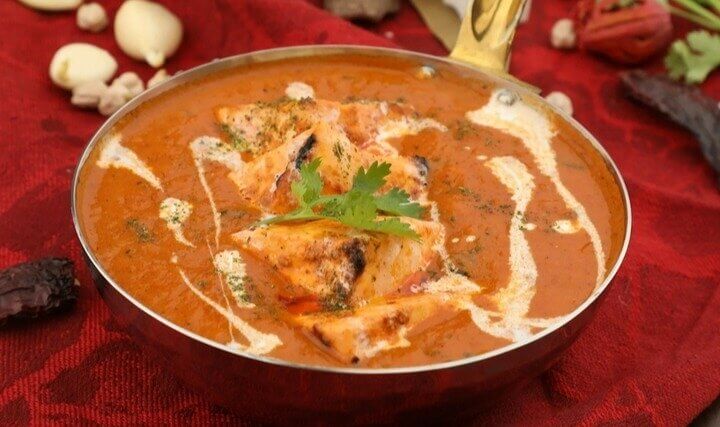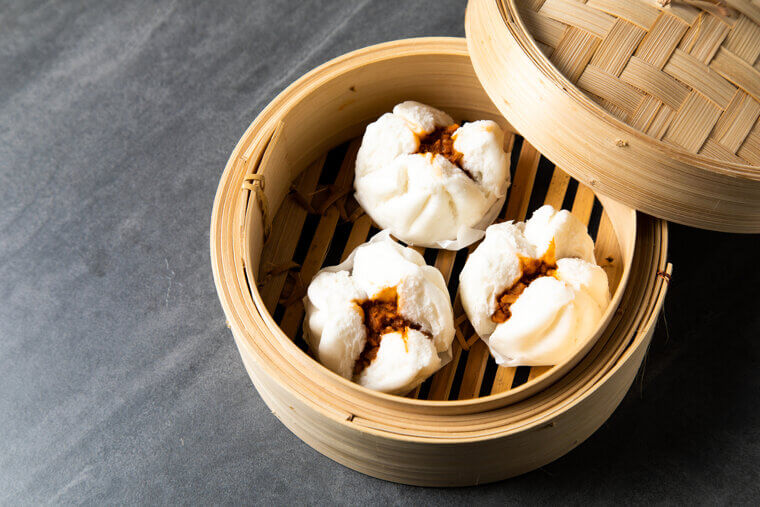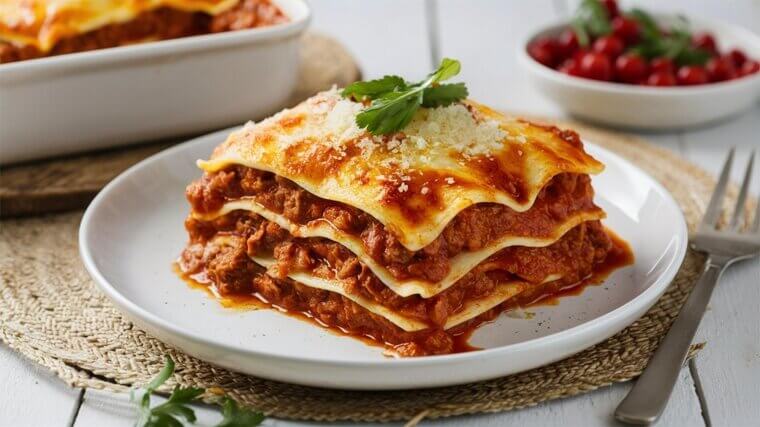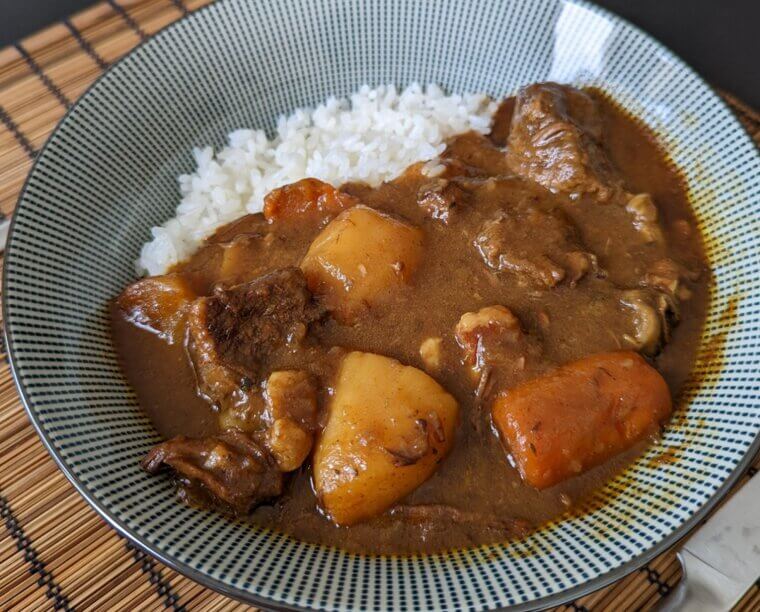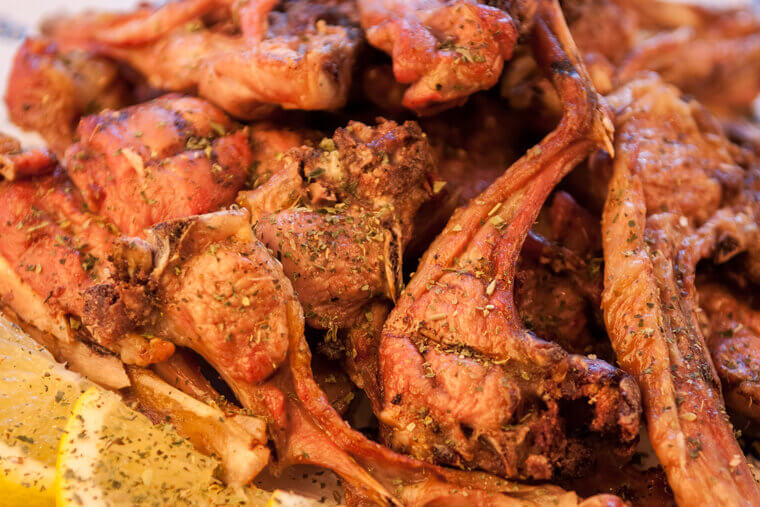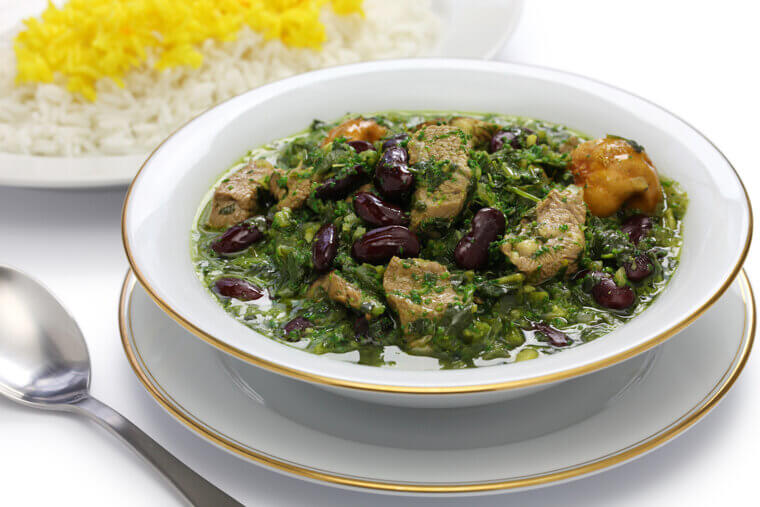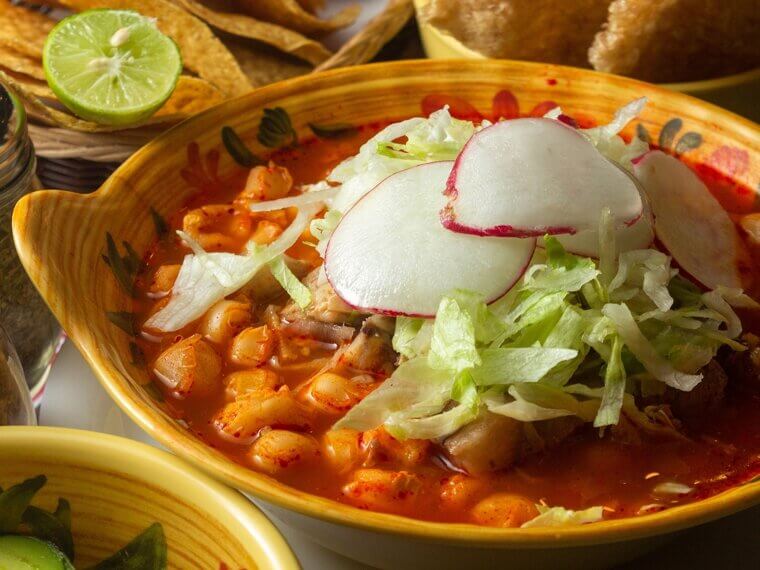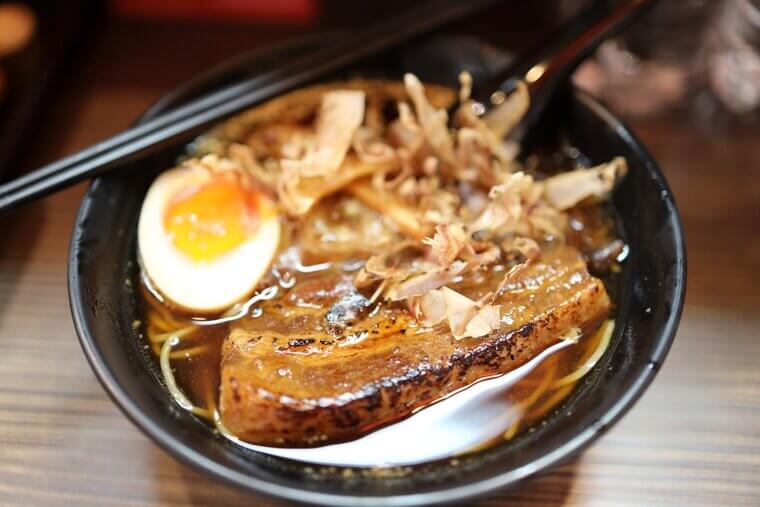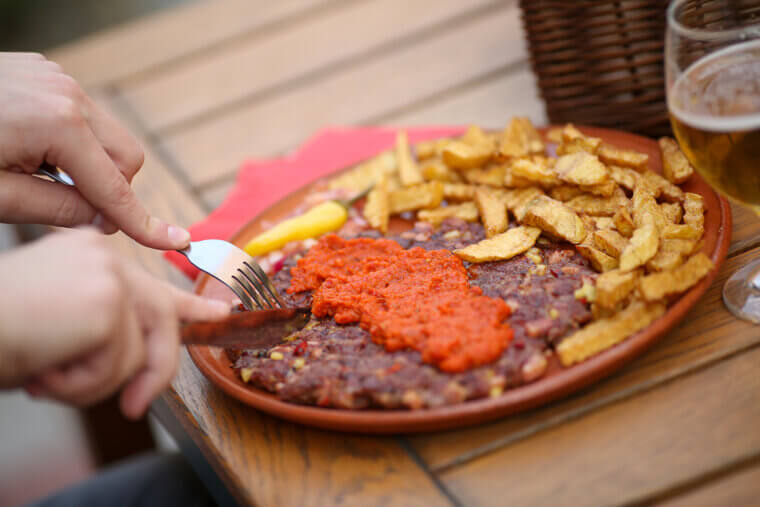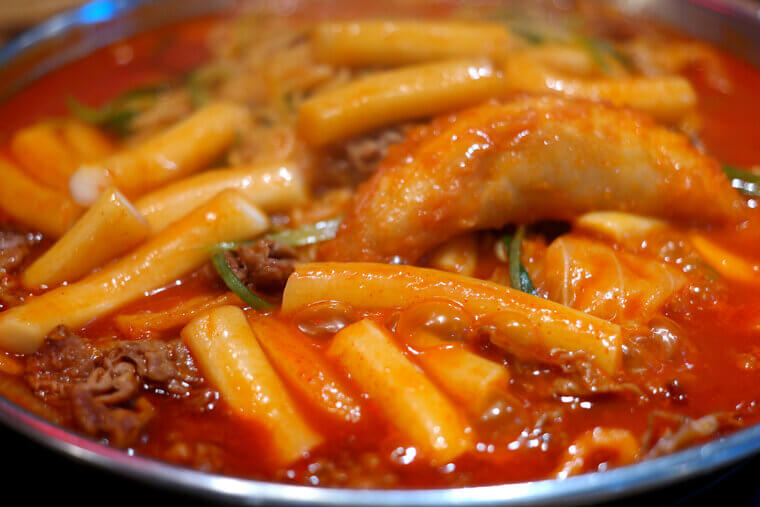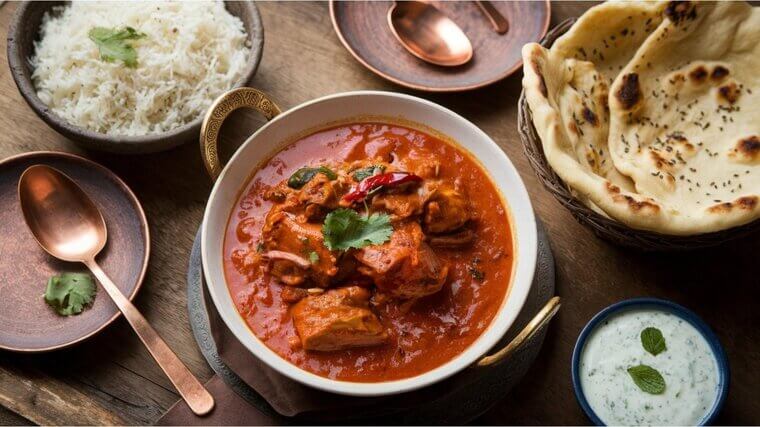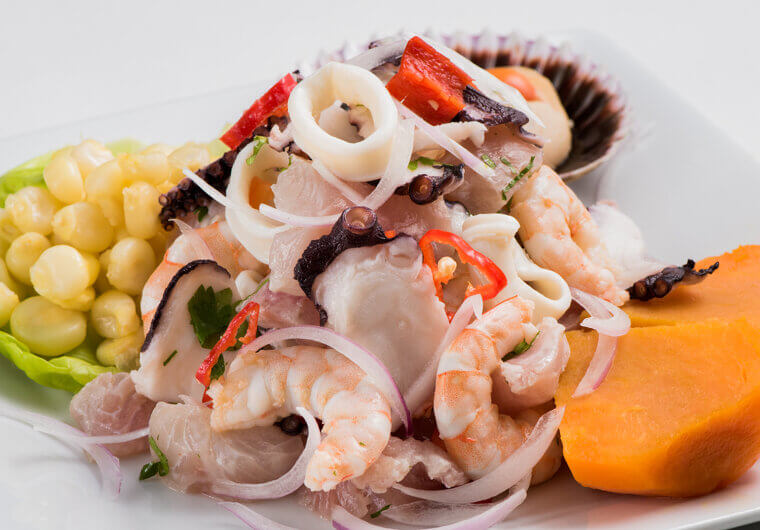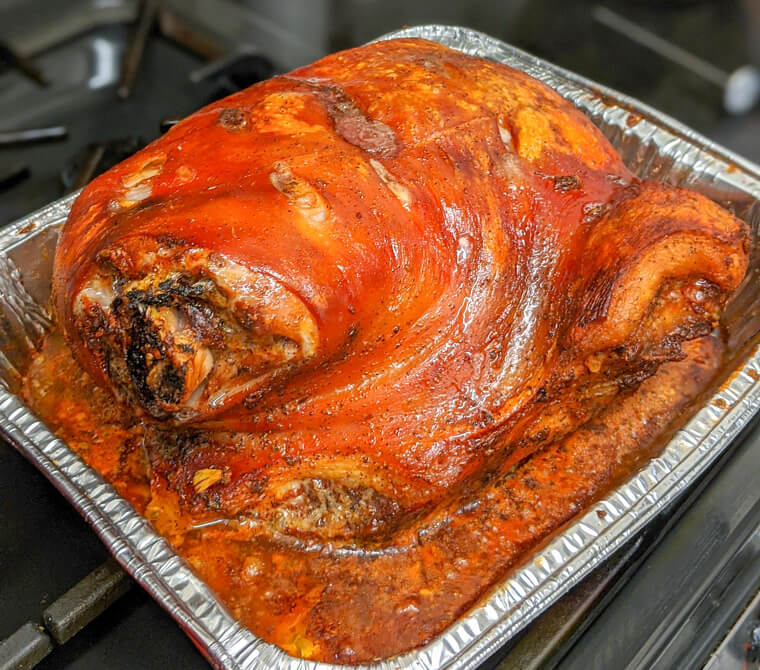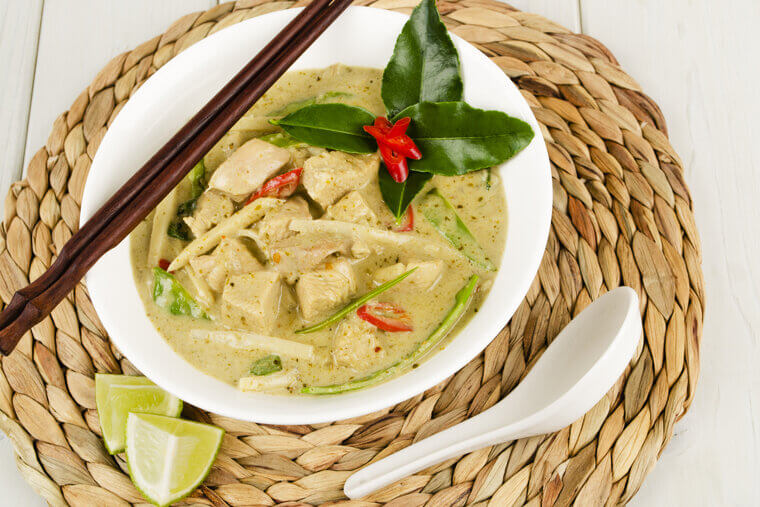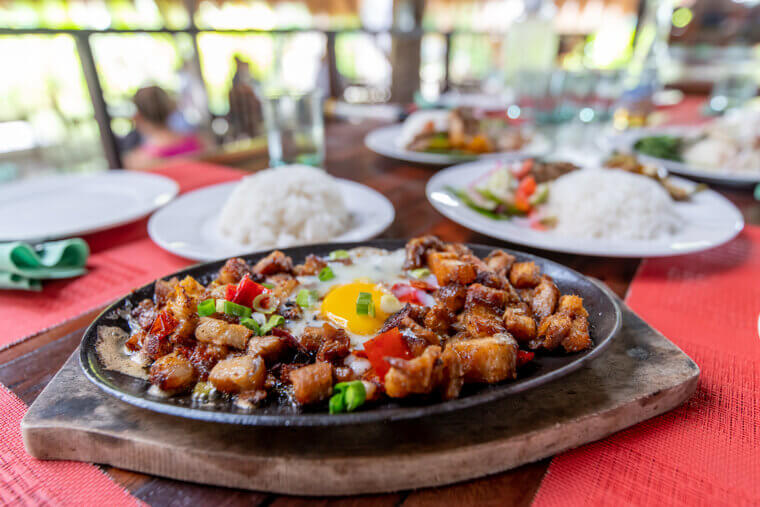Khinkali – Georgia
Khinkali are dumplings that hail from Georgia and feature meat, fish, or vegetables stuffed into a twisted dough casing. When in Georgia, it's common to see the locals eat khinkali with their hands and forgo utensils completely, as well as leave the very tip of the dumpling on the plate. It's considered to be one of the most popular foods in Georgia, with a history that traces back to the Mongolian conquests of the 13th century, possibly via trade happening on the Silk Road.
Wherever it originated, these extra-large dumplings have been embraced by the local nation for good reason and today are recognized as a classic dish.
Bakaliaros – Greece
Bakaliaros means cod fish in Greek and is typically eaten on the 25th of March all around the country. A generously salted cod fish is fried in a beer batter and usually served with some type of potato dish on the side—what's not to like! The cod fish dish is eaten in celebration of the religious festival, the Annunciation of the Virgin Mary, which coincidentally also falls on the Greek War of Independence against the Turks between the years 1821 to 1829.
Some people serve their bakaliaros with fries, while others opt for well-seasoned mashed potatoes. Regardless, it's a hearty Greek meal that's enjoyed by most families at least once a year.
Raclette Cheese – Switzerland
Raclette cheese traces its origins back to Switzerland, but it's also a much-loved food in other countries in alpine regions like France, Germany, and Austria. It's easy to see how it became a firm favorite – it involves a large wheel of cheese, which is heated on one side. Part of the cheese melts and oozes, then is scraped off to enjoy on top of another dish. What's not to love! Traditionally, the cheese is served with fermented cucumbers, onions, or potatoes and accompanied by a hot drink. The French, however, have taken to enjoying their melted cheese with white wine!
If you ever find yourself in a part of the world where you can try raclette, you simply must treat yourself to this velvety, rich cheese dish at least once.
Yaki Udon – Japan
People love Udon noodles for their chunky, chewy texture and quick turnaround time from wok to plate. But Yaki Udon noodles are a much-loved favorite for Japanese people because they incorporate the thick wheat noodles alongside stir-fried vegetables and meat, mixing everything together in a soy sauce base. It's the perfect meal when you're low on time and in need of something quick and tasty for dinner. While the exact origins of Udon noodles remain a mystery, they are believed to have been brought over from China around 1,200 years ago, experiencing a resurgence in Japan during the Second World War when Soba noodles became a rarity.
You can even replace the meat with tofu if you're looking to make the dish vegetarian-friendly, but just be sure to top each plate with a generous handful of chopped spring onion.
Steak Au Poivre – France
Steak au poivre isn't just a fancy French way to ask for a steak in a French restaurant—it's a beef steak that's been generously coated in a thick layer of black, green, or white peppercorns and pan-seared in butter. Typically, a filet mignon is used, which contrasts perfectly with the strong pepper flavor and creamy sauce. The key to mastering this dish is to cook the steak at a high temperature, leaving the inside quite rare, and making sure that the cooked dish is left to rest for a long enough amount of time after it's taken off the fire.
It's common to serve steak au poivre with a potato dish, such as mashed potatoes or fries, and a sacuer with some mustard on the side.
Khachapuri – Georgia
Khachapuri is considered to be a national dish of Georgia and consists of fluffy sliced bread filled with cheese and eggs. It can be found in restaurants as a side dish or picked up as street food, but it never disappoints. Typically, this bread or pastry is shaped like a boat—a fitting shape considering how it is said to have originated from sailors. Generally, feta, mozzarella, or Parmesan cheese is used, and it has even been termed the "cousin of the pizza" by a former Georgian Culinary Academy professor. Depending on the region, the variation of khachapuri will change, with some places using different cheeses or adding things like potatoes and butter.
Most importantly, this dish needs to be served piping hot and straight from the oven; otherwise, the cheese runs the risk of tasting bitter due to the combination of cheese flavors.
Pan Fried Gyoza – Japan
Gyoza are dumplings filled with ground meat and finely chopped vegetables, wrapped in a flour pastry dough and fried. Traditionally, they are filled with pork, mushrooms, and cabbage, but these days they can consist of different variations of meat and vegetables. Sometimes chives, ginger, garlic, and spring onions are chopped up finely and added to the minced meat, but they almost always look similar in a thin dumpling casing. They're also known as potstickers and are typically served with soy sauce and chili oil in Japan. This delicious dish is usually eaten as an appetizer to another meal.
Interestingly, this popular dish is less than 100 years old in its current form, having developed during the Second World War after soldiers returned from China.
Gnocchi Alla Sorrentina – Italy
Gnocchi Alla Sorrentina is considered to be a comfort meal for Italians all across the country, although it originally came from Campania. Essentially, it is a gnocchi dish in a mozzarella cheese, tomato sauce, and basil base that's cooked in a pignatiello clay pot. The gnocchi is cooked until the cheese bubbles and is sometimes allowed to cook for longer until the edges become brown and crispy. To top it off, you can grate some Parmesan or Pecorino on top to give it that extra cheesy edge and a slight variation in texture.
Best of all, all the ingredients are readily available in most places, so you don't have to wait until you take a trip to the boot-shaped country to try this beloved dish.
Gambas Al Ajillo – Spain
Spain is famous for its tasty seafood dishes, and one of the most popular to come from Spain is the flavorful Spanish garlic shrimp, or Gambas al Ajillo. Juicy shrimp packs a punch thanks to the spicy garlic flavor, which is sautéed in a generous amount of olive oil and lemon juice. Traditionally, the dish is flavored with paprika and spicy pepper and topped with chopped parsley before being served on the dinner table with some lightly toasted bread.
This dish is so popular in Spain, it's become a regular in restaurants and cafes all across the country. We certainly wouldn't say no to such a tasty-looking appetizer.
Souvlaki – Greece
Greece has a different take on fast food than we do over here. Over there, souvlaki is considered to be a typical item of street food that consists of small chunks of meat and sometimes vegetables suspended on a skewer and grilled. It's considered to be fast food because it takes no more than a few minutes to cook and is eaten piping hot straight off the grill. Any meat can be used for souvlaki, so whether it's chicken, pork, beef, lamb, or even sometimes cheese, it all counts.
The people of Greece typically choose to eat souvlaki alone as an appetizer or sometimes stuffed into pita bread. However they are chosen to be eaten, they're always a delicious addition to any meal.
Miso Ramen – Japan
Luckily, you don't have to travel to Japan to taste their famous miso ramen dish anymore. Many Japanese food places offer this delicious hot dish all over the world, with variations as to exactly what goes into the pot. It consists of ramen noodles that are flavored with miso seasoning—a thick paste made out of fermented soybeans and kōji (a certain fungus)—and topped with chicken stock, meat (usually sliced pork or beef), and a soft yolk egg. It's basically the best ramen dish you'll ever eat in your life. Many times, you'll also find an assortment of vegetables in your miso ramen, too, from sweet corn to mushrooms.
Crucially, the meat stew should be cooked for a long time to add more richness in flavor, making it a very satisfying dish for savory food lovers.
Pasta Carbonara – Italy
A classic pasta carbonara is a firm favorite for good reason—it consists of a rich cheesy sauce with guanciale and spaghetti, an irresistible combination! It has strong ties to the ancient city of Rome, but interestingly, it actually originated in Naples and has only been around since 1944. There is controversy as to whether or not the inventor of the dish was actually an American soldier who had visited Italy, but regardless, it is beloved by Italians up and down the country.
Finely chopped guanciale, also known as pork cheek, is a key ingredient, as is mixing an egg yolk into the creamy Parmesan or Pecorino Romano sauce.
Manti – Turkey
Anyone who's eaten Turkey's famous manti raviolis knows why they've made it onto this list, as they consist of a unique blend of rich flavors all centered around a lamb base. These raviolis are stuffed with minced lamb and chives, baked, and then topped with a blend of three distinct sauces: a caramelized tomato sauce, garlic yogurt, and brown butter. Turkey has other popular ravioli or dumpling dishes such as the hingel and Tatar böreği, but most notably, they are usually served in much smaller portions than the manti.
Manti are also made in Anatolia, the Transcaucasus, and Armenia, but the way that the raviolis are prepared varies greatly from place to place.
Tonkotsu Ramen – Japan
The Tonkotsu ramen dish comes from the Japanese Kyushu island and is considered to be a specialty of the area. Their ramen consists of sliced pork belly, pork bone broth, firm noodles, a sliced egg, and tare sauce. But it's not uncommon for other ingredients like kelp, mushrooms, soy sauce, chili bean paste, or sesame seeds to make their way into the Tonkotsu ramen, either. The word tonkotsu actually means "pork bones," so it's hardly surprising that they're such a key ingredient in this delicacy. Invented in 1937, the broth is usually cooked for several hours until the soup is cloudy in appearance.
These days, you don't have to travel all the way to the island of Kyushu to taste it, as it's served in restaurants all over the country.
Gyro – Greece
Greece is famous for its love of gyro, a lamb, chicken, or beef dish that sees the meat spit-roasted on a vertical rotisserie and then typically served up in pita bread. Served hot off the skewer, it is stuffed in the pita with other vegetables like tomatoes and lettuce, and sometimes even fries. Tzatziki yogurt is usually the sauce of choice, making it easily comparable to the Turkish kebab.
That being said, it's often topped with ketchup and mustard in the northern parts of the country. It's one of the most readily found meals in Greece that's much beloved by the local population.
Peking Duck – China
Peking duck is a dish from China with a long history, having been eaten since sometime in the great Imperial age. There was a time when this dish was almost exclusively served to the upper classes, but luckily today it's a staple in many Chinese restaurants around the world. It consists of a well-seasoned duck with a thin and crispy skin, often carved in front of diners and eaten alongside a sweet sauce and pancakes. While there are different ways of cooking the duck, the dish itself has become a symbol of China's gourmet cuisine for citizens and outsiders alike.
A key characteristic of the Peking duck dish is its glossy brown skin, making it a feast for the eyes as well as the taste buds.
Cacio E Pepe – Italy
Cacio e Pepe is a simple-looking dish with a simple ingredients list, but it has all the depth of a more complex recipe, making it a firm favorite in Italy. It's believed to have come from the shepherds of the religious communities in Abruzzo, Tuscany, Lazio, and Umbria sometime between the 18th and 19th centuries, and simply translates to "cheese and pepper" in Italian. Apparently, it originated from the shepherds' need to eat pasta alongside ingredients that have a long lifespan as they moved around a lot from one place to another. Essentially, spaghetti is cooked like normal before being added to grated Pecorino cheese and topped with black pepper.
You then add a small amount of the salty pasta water on top to help melt and bind the cheese, but that's about as complicated as it gets.
Massaman Curry – Thailand
Thailand's massaman curry combines cuisines from two different cultures in one delicious dish. There are influences from both India and Malaysia in this curry, combining warm spices like nutmeg, cinnamon, and cloves alongside coriander seeds, cumin, and cardamom. It's perfect for those of you who love the taste of curry but aren't that great at handling spicy food. This dish will give you just the right kick without having you guzzling water. The curry is cooked with coconut milk to give it a rich, creamy taste and can be served with potatoes, rice, and your choice of meat.
To really amp up the dish and make it just like they do in Thailand, sprinkle some chopped peanuts over the top of the plated dish and serve while hot.
Tonkatsu – Japan
Tonkatsu is frequently associated with the ramen dish of the same name, but when said alone, it usually refers to the deep-fried pork chop dish that's beloved by many. It's made up of a thick pork cutlet that's been coated in egg wash, dipped in panko, and sliced before being deep-fried until the skin is crispy and a deep shade of orange. It's certainly not the healthiest dish you'll find at a Japanese restaurant, but it's one of the tastiest.
The history of this delicious delicacy goes back to the 19th-century Meiji Era and is a take on a French dish called côtelette de veau, which also sees a cutlet of meat dipped in breadcrumbs and fried.
Ebi Furai – Japan
Ebi furai, not to be confused with ebi tempura or ebiten, is a Japanese deep-fried prawn dish that typically has a dark and crunchy texture. It consists of shrimp that has been dipped in an egg wash and coated in breadcrumbs with their tails still on, and can also be served alongside noodles and rice. It is usually the type of fried shrimp that you'll find included in bento boxes. Its origins date back to 1900 during the time when western restaurants in Tokyo were combining cuisines, and it has since become a specialty of the city of Nagoya, with many Japanese nationals associating the dish with the city.
While there are a number of deep-fried shrimp dishes in Japanese cuisine, this particular dish has captured the hearts of many both in and outside of Japan.
Cochinita Pibil – Mexico
Cochinita Pibil originates from Mexico's Yucatán Peninsula and typically includes boneless pork shoulder that has been pulled and marinated in citric juices such as lemon juice, lime juice, and orange juice. You'll usually find that the annatto seed has also been added to the dish to give it its trademark bright orange hue, which will then have been roasted in an earth oven while wrapped in a banana leaf.
It's much loved for having the tenderness that only comes from a slow cook and will typically be enjoyed alongside some corn tortillas, beans, onions, and chilies.
Carnitas – Mexico
Carnitas are a staple of Mexican cuisine and have been ever since the 19th century. They are actually a variation on a French dish called Chicharrones de Tours and were typically served to people of a lower class. But these days, they are celebrated for the delicious delicacy that they are and consist of pulled pork that has been braised, simmered, and fried for a few hours overall. You typically find it served in tortillas, tortas, or burritos, with some diced and sliced vegetables and frijoles refritos.
There's no dish that satisfies those meat cravings more than one that includes Mexican carnitas, especially when they are made by the locals themselves and served alongside all the usual trimmings.
Shahi Paneer – India
Shahi paneer, also known as Paneer Rajwadi or Chhena Rajwadi, is an aromatic Indian dish that is extremely popular in Mughlai cuisine. It's known for its thick and creamy sauce, which oftentimes includes yogurt or cottage cheese, as well as tomatoes and a variety of Indian spices. You'll typically find it served alongside some fresh butter naan bread, tandoori roti, or rice. It's known for having a sweeter taste than other curries and typically brings to mind royal families, as some of the names used are associated with notable lineages.
Essentially, shahi paneer is perfect for those of you who are looking for a comfort food dish that has all the incredible flavor and spice that's synonymous with Indian cuisine, but who also want something creamy and buttery in texture.
Char Siu Bao – China
Cha siu bao is a Cantonese Chinese dish that is a favorite among Chinese bakeries around the world. At their core, they consist of sweet roasted pork stuffed inside a fluffy white bun alongside some finely chopped chives and shallots. This dish isn't typically consumed at night, however, with people generally opting to eat it earlier in the day until the early afternoon. It's not uncommon to eat this delicious sweet and savory treat with a cup of tea to wash it all down, but depending on the country in which you eat cha siu bao, the color may vary.
In Hong Kong, it is more common to find these buns in a bright white color to contrast with the brown glossy pork center. Importantly, they are always eaten hot and fresh off the steamer.
Lasagne Alla Bolognese – Italy
Studies find that lasagna goes all the way back to ancient Rome at the earliest, with other theories claiming that the origin of the beloved pasta dish is even older than that. Either way, it is a staple of Italian cuisine and consists of sheets of pasta dough that are cut into neat strips and stacked in layers of meat, cheese, and other seasonings. The exact details vary, but generally include ragù, various cheeses (such as ricotta and mozzarella), and béchamel sauce. It's not uncommon to find vegetables in the layers of lasagna, however, and once baked fully in the oven, they make for a delicious and creamy dish.
Lasagna is altered slightly from place to place depending on the region, with the northern regions using flour and eggs for their pasta base while southern areas rely on semolina and water.
Karē – Japan
The Japanese karē dish is a favorite among Japanese food enthusiasts and has been popular ever since the Meiji era of the 19th century. It used to be a dish reserved mostly for affluent members of society, but it is now available to all types of economic classes. It consists of a curry that is dark in hue and usually has a thicker consistency than most curries from other countries.
When visiting Japan, you can usually choose to have your karē in one of three ways: accompanied with sticky rice, accompanied with udon noodles, or inside a pastry.
Paidakia – Greece
Everyone who knows anything about Greek cuisine knows how much they love their lamb. Which is why paidakia is such a beloved dish all across the country, as it consists of grilled lamb chops. You'll usually find them cooked straight on a coal barbecue, where they pick up that great smoky flavor and are seasoned with a generous amount of olive oil and lemon juice. When served, Greek people like to eat their paidakia alongside some fries, known as patates tiganites, and a refreshing tzatziki sauce, as well as side salads.
This zesty dish simply can't be beaten when you're in the mood for a smoky barbecue that has all the flavors of Mediterranean cuisine.
Ghormeh Sabzi – Iran
Ghormeh sabzi is thought to be the national dish of Iran, so it's unsurprising to learn that it's eaten up and down the country. There are many different variations of this dish, but they almost always comprise dried herbs, kidney beans, and chunks of meat. The herbs used are generally fenugreek leaves and dried Persian limes, with fresh parsley added right at the end. Typically, the meat will be beef or lamb, and kidney beans are a must-have addition. The sauce is usually seasoned with plenty of turmeric, as well as onions and garlic.
It's worth noting that there can be much debate among Iranians as to the correct ingredients to use in the national dish, but it is nonetheless a prominent part of Iranian cuisine.
Pozole – Mexico
Pozole is an authentic Mexican broth with a pork or chicken base. It has a long history that dates back to the pre-Hispanic civilizations living in Mexico, and the name literally translates to the words "boiled" or "foamy," referencing the burst corn kernels present in the soup. Originally, it was a broth that was made for religious ceremonies that typically involved ritual sacrifice, but it has since become a hearty staple of modern-day Mexican cuisine.
That being said, the exact contents of the broth differ from region to region, but it can usually be found whenever there's a party or festival happening.
Shoyu Ramen – Japan
Some people call shoyu ramen chu-ka soba, but they both refer to the same Japanese delicacy. This specific ramen is said to have come about in 1910, having been first described as "Tokyo ramen," which some places in Japan still call it to this day. It's known for having a rich umami flavor, a myriad of toppings, and a long cooking time that's essential for instilling the broth with a deep and rich flavor. It's usually combined with curly noodles and chashu pork belly, as well as some finely diced spring onion, bamboo shoots, and rehydrated dried mushrooms.
Don't be surprised if you also find some sliced narutomaki inside the ramen bowl, too. It's a surimi fish cake with pink swirls inside a white cloud shape and is a staple in ramen from the Tokyo area.
Pljeskavica – Serbia
Pljeskavica is native to Serbia, but it's also a popular dish in neighboring countries such as Croatia, Bosnia and Herzegovina, and Montenegro. Essentially, it's a meat patty that has a lot in common with modern-day hamburgers, as it features a circular slab of minced meat such as beef, lamb, or pork. It's not uncommon for different meats to be combined for an extra complex flavor. Usually, pljeskavica is seasoned with paprika and grilled until a crisp brown skin starts to form.
Pljeskavica is typically eaten with fries, beans, onions, clotted cream, eggplants, a spicy cheese salad, flatbread, or an assorted combination of these dishes.
Tteokbokki – Korea
Tteokbokki is considered to be one of the best dishes in Korea and is frequently depicted on screen. You don't have to go to a restaurant to try this delicious dish, as it's a staple in Korean street food, consisting of spicy rice cakes, boiled eggs, and scallions in a spicy red chili broth. There's nothing quite like the texture of these soft and chewy rice cakes; you really do need to try them to experience what we're talking about.
Its history goes all the way back to the Korean royal palace, but it has since been adapted to modern times and changed a lot throughout history. Nonetheless, it's extremely tasty and addictive!
Vindaloo – India
India's vindaloo curry isn't just a favorite in its country of origin—it's also a staple in Indian restaurants all across Britain and is much beloved for having a punchy, spicy flavor. Originally, it was made with pork, but pork is often replaced with other proteins such as chicken, lamb, beef, tofu, and even seafood. The dish itself was inspired by a Portuguese dish called carne de vinha d'alhos (which translates to "meat of vine of garlic") and was initially a meal prepared by Portuguese sailors.
Generally speaking, a vindaloo curry in Britain is one of the spiciest curries available at the curry house, and the name is synonymous with the hottest dish available.
Frango Assado Com Piri Piri – Portugal
Frango assado com piri-piri, also just referred to as frango assado, is a Portuguese dish that translates to "roasted chicken." The origins of this dish remain somewhat of a mystery, but it does have a flavor profile that is similar to Mozambique's piri-piri chicken. It has been around since the 1970s, where it is suspected that the dish was created after Portuguese people returned home after traveling around Angola and Mozambique and bringing back local spices.
Whatever the true origins of frango assado com piri-piri are, it consists of a whole chicken marinated in crushed piri-piri peppers and olive oil, along with some garlic, lemon, paprika, and coriander.
Kotlet Schabowy – Poland
Poland's Kotlet Schabowy has been compared to the French côtelette de veau frite (also known as côtelette Menon), the North and South American milanesa, the Viennese schnitzel, or the Italian cotoletta, as it consists of a meat cutlet that's been coated in breadcrumbs and pan-fried until brown. Much like its European counterparts, the meat (usually pork) is drenched in egg yolk and then dipped in a mix of breadcrumbs and flour.
That being said, it's also usually marinated in a milk and onion concoction and served alongside a mashed potato or sliced potato dish, cooked cabbage, coleslaw, and pan-fried mushrooms.
Ceviche Mixto – Peru
One of Peru's most famous dishes is ceviche mixto, which actually combines flavors from distinctly different cuisines. There are influences from Spain, influences from Japan, and even the Incan Empire, but somehow they all combine perfectly into this much-beloved Peruvian dish. It consists of chunks of raw ocean white fish, plenty of lime juice, chili peppers, onions, and fruit. The specific fruit and fish that are used depend on the season, but fish like sea bass, halibut, flounder, and sole are used, as well as fruits like avocado, grapes, and cherry tomatoes.
It's also possible to find ceviche mixto with cooked seafood included as well, such as shrimp, calamari, or octopus that has been marinated in lime juice.
Moqueca – Brazil
Brazil is famous for its moqueca stew, which is composed of seafood or fish, garlic, bell peppers, tomatoes, onions, and coconut milk at its core. When served, fresh cilantro is sprinkled over the top, and typically the dish is served with rice. It's a stew with a spicy kick and a creamy broth that nourishes from the inside out. When eaten in Brazil, it's normal to have this dish served in the clay pot with which it was cooked, still bubbling from the heat! It originates from the northeastern state of Bahia, a state celebrated for its Afro-Brazilian cuisine and culture, and moqueca is no exception to that.
The history of this tasty dish goes back 300 years to when Portuguese sailors first brought coconuts in to the country through the coastal shores of Brazil.
Pernil – Puerto Rico
Pernil is a celebrated dish in Puerto Rico, but it has roots in Spain. It is composed of slow-cooked roast pork, preferably taken from the rump or the shoulder, and pork was introduced to the country by Spain during the second voyage of Christopher Columbus in 1493. The pork dish is favored by the locals during the festive season, particularly around Christmas, and is typically served alongside a dish of rice.
People love the tender, melt-off-the-bone meat that comes from slow cooking and the thin, crispy brown skin that makes it worthy of the holiday period.
Kaeng Khiao Wan – Thailand
Kaeng khiao wan is the native name for Thailand's famous green curry, originally a dish that hails from southern Thailand and features goat meat at its core. These days, goat meat is typically replaced when outside of Thailand with proteins like tofu or chicken, but it generally maintains the core seasonings like green chillies, garlic, shallots, lemongrass, coriander, and cumin seeds. It's also common to include bamboo shoots or shrimp paste, but most importantly, it uses coconut milk to create that creamy curry sauce.
Typically, Thai green curry is served with plain jasmine or basmati rice or a plate of hot dry noodles, but either way, it's absolutely delicious.
Sisig – Philippines
One of the most famous dishes to come out of the Philippines is a dish called Sisig, a delicacy that originates from Luzon's Pampanga region. It is considered to be a classic of Kapampangan cuisine and features pork belly, pork jowls, and chicken liver, cooked in a spicy and sour sauce. The meat is finely chopped, as are the other ingredients like onions, chili peppers, and calamansi (a Filipino lemon).
Interestingly, the name sisig comes from an old Tagalog word, "sisigan," which translates to "make it sour." But best of all, this dish provides you with a variety of punchy flavors and textures.
